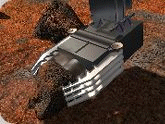



| Intro
| |
Nowadays, the word "robot" is often applied to any device that works automatically or by remote control, especially a machine ("automaton") that can be programmed to perform tasks normally done by people. Earlier this century, "robot" usually meant a manlike mechanical device ("mechanical man" or "humanoid") capable of performing human tasks or behaving in a human manner. What all robots have in common is that they perform tasks that are too dull, dirty, delicate or dangerous for people.
The word "robot" was coined in 1920 by playwright Karel Capek from the Czech
word "robota", meaning forced labour
or drudgery. In Capek's play R.U.R. (for
Rossum's Universal Robots), human-like mechanical creatures produced in
Rossum's factory are docile slaves until
one misguided scientist gives them emotions. The robots revolt, kill all humans
and take over the world! | |
| Laws of Robotics
| |
The term "robotics" was coined in the 1940s by science fiction writer Isaac Asimov. In a series of stories and novels, he imagined a world in which mechanical beings were mankind's devoted helpmates. They were constrained to obey what have become known as Asimov's Laws of Robotics: 1.A robot may not injure a human being or, through inaction, allow a human being to come to harm. 2.A robot must obey the orders given it by human beings, except where such orders would conflict with the First Law. 3.A robot must protect its own existence, as long as such protection does not conflict with the First or Second Law.
Although they originated in the 1940s, they
are still considered good standards for robots today. | |
| NASA | |
|
Since its inception in 1958, NASA has accomplished many great scientific and
technological feats in air and space. NASA technology also has been adapted
for many non-aerospace uses by the private sector. NASA remains a
leading force in scientific research and in stimulating public interest in
aerospace
exploration, as well as science and technology in general. Perhaps more
importantly, our exploration of space has taught us to view the
Earth,ourselves, and
the universe in a new way. While the tremendous technical and scientific
accomplishments of NASA demonstrate vividly that humans can achieve previously
inconceivable feats, we also are humbled by the
realization that Earth is just a tiny "blue marble" in the cosmos.
| |
| History
| |
|
October 1, 1958, the official start of the National Aeronautics and Space
Administration (NASA), was the beginning of a rich history of unique scientific
and
technological achievements in human space flight, aeronautics,space
science, and space applications. Formed as a result of the Sputnik crisis of
confidence,
NASA inherited the earlier National Advisory Committee for
Aeronautics (NACA), and other government organizations,and almost immediately
began
working on options for human space flight. NASA's first high profile
program was Project Mercury, an effort to learn if humans could survive in
space,
followed by Project Gemini, which built upon Mercury?s successes and
used spacecraft built for two astronauts.NASA?s human space flight efforts then
extended to the Moon with Project Apollo, culminating in 1969 when
the Apollo 11 mission first put humans on the lunar surface. After the Skylab
and
Apollo-Soyuz Test Projects of the early and mid-1970s, NASA?s human
space flight efforts again resumed in 1981, with the Space Shuttle program that
continues today to help
build the International Space Station. Building on its NACA roots, NASA has continued to conduct many types of cutting-edge aeronautics research on aerodynamics, wind shear, and other important topics using wind tunnels, flight testing, and computer simulations. NASA?s highly successful X-15 program involved a rocket-powered airplane that flew above the atmosphere and then glided back to Earth unpowered, providing Shuttle designers with much useful data. The watershed F-8 digital-fly-by-wire program laid the groundwork for such electronic flight in many other aircraft including the Shuttle and high performance airplanes that would have been uncontrollable otherwise. NASA has also done important research on such topics as "lifting bodies" (wingless airplanes) and "supercritical wings" to dampen the effect of shock waves on transsonic aircraft. Additionally, NASA has launched a number of significant scientific probes such as the Pioneer and Voyager spacecraft that have explored the Moon, the planets, and other areas of our solar system. NASA has sent several spacecraft to investigate Mars including the Viking and Mars Pathfinder spacecraft. The Hubble SpaceTelescope and other space science spacecraft have enabled scientists to make a number of significant astronomical discoveries about our universe. NASA also has done pioneering work in space applications satellites. NASA has helped bring about new generations of communications satellites such as the Echo, Telstar, and Syncom satellites. NASA?s Earth science efforts have also literally changed the way we view our home planet; the Landsat and Earth Observing System spacecraft have contributed many important scientific findings. NASA technology has also resulted in numerous "spin-offs" in wide-ranging scientific, technical, and commercial fields. Overall, while the tremendous technical and scientific accomplishments of NASA demonstrate vividly that humans can achieve previously inconceivable feats, we also are humbled by the realization that Earth is just a tiny "blue marble" in the cosmos. |